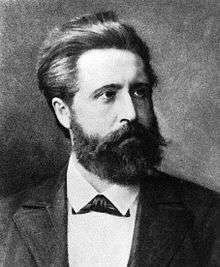Philipp Scharwenka
Ludwig Philipp Scharwenka (16 February 1847, Samter, Grand Duchy of Posen – 16 July 1917, Bad Nauheim) was a German composer and teacher of music. He was the older brother of Xaver Scharwenka.
Ludwig Philipp Scharwenka | |
|---|---|
 L. P. Scharwenka | |
| Background information | |
| Born | 16 February 1847 Samter, Prussia |
| Died | 16 July 1917 (aged 70) Bad Nauheim, Germany |
| Genres | Classical |
| Occupation(s) | Pianist, composer |
| Instruments | Piano |
Early training
He was born in Samter, Grand Duchy of Posen. Like his younger brother Xaver he received his first intermittent musical instruction in Posen. After the closure of the Gymnasium (college) in 1865 he studied music theory together with his brother under Richard Wüerst and Heinrich Dorn at the new Musical Academy in Berlin where, from 1868, he himself was taken on as teacher of Theory and Composition. In this period his own first compositions appeared. In 1874 he brought out an overture and a symphony for the first time in a concert of his own.[1]
Compositions
His many teaching obligations notwithstanding, Philipp Scharwenka stood in the front line as a composer and was recognised as such during his lifetime. His compositions include three Symphonies, Symphonic Poems, a Violin concerto,[2] some Choral works (of which Sakuntala became very famous), the 4-act opera Roland, as well as numerous instrumental works such as Sonatas, Quartets, Caprices and Dances. Many of the major conductors of the period, including Arthur Nikisch, Anton Seidl and Hans Richter, performed his orchestral works. He is still known for his chamber works, including two piano trios,[3] two trios for violin, viola, and piano,[4] two violin sonatas,[5] one viola sonata,[6] one cello sonata,[7] two string quartets,[8] and one piano quintet.[9]
In contrast to his brother's very extroverted compositions, Philipp's many-sided works have dreamlike and thoroughly moody inflections. His best-liked works are the chamber works beginning in 1896, which maintain traditional formal models and show considerable variety of melodic and rhythmical invention. In them Scharwenka achieved (despite the conservative restraints of the time in which he was writing) through very refined compositional techniques, something approaching an impressionistic tonal palette. These works found such distinguished interpreters as Willy Burmester, Julius Klengel and Moritz Meyer-Mahr.
One of his admirers was Max Reger, who in 1898 dedicated his Phantasiestücke op. 26 to him. In the context of the 37th Composer-Congress in 1900, his Dramatic Fantasy for Orchestra op 108, being crowned with a prize by the National German Music-Society, was performed in Bremen.
Conservatory director
At the opening of the Scharwenka-Conservatory in Berlin, his brother Xaver entrusted to him in 1881 the direction of the Theory and Composition teaching, and then in 1891 that of the sister-conservatory in New York. Philipp however returned to Berlin in 1892 to take control of the Conservatory there, which in 1893 he merged with the Piano School of Karl Klindworth to form the Klindworth-Scharwenka Conservatory. This went on to become an outstanding institution in the musical landscape of Berlin. As Director of the Conservatory, Scharwenka remained active until his death in 1917. Otto Klemperer studied with him in Berlin, and Oskar Fried was another very distinguished pupil of his. See: List of music students by teacher: R to S#Philipp Scharwenka.
Other
In 1880 Philipp married violin virtuoso Marianne Scharwenka (Marianne Stresow, d. 1918). In 1937 his son Walter Scharwenka took over as director at the Conservatory.
Also Scharwenka possessed a remarkable talent as graphic illustrator, which is seen, for instance, in the drastic-humorous Figures for Alexander Moszkowski's satire, Anton Notenquetscher.
Notes
- The text of this article mainly consists of a translation from the German Wikipedia.
- his opus 95, in G. Scharwenka, Philipp (1895). "Scan of Philipp Scharwenka's Violin Concerto". Leipzig. Archived from the original on 2018-11-01. Retrieved 2009-01-28.
- in C♯ minor op. 100 OCLC 21025441 and op. 112 in G OCLC 26326905
- in A major op. 105 OCLC 67759543 and in E minor op. 121 OCLC 2942186
- in B minor op. 110 OCLC 174182416, in E minor op. 114 OCLC 11663269
- op. 106 in G minor
- op. 116 in G minor
- op. 117 in D minor; op. 120 in D major - OCLC 67858047
- op. 118 in B minor - OCLC 21837829
External links
- Image of Philipp Scharwenka on German Wikipedia, de:Philipp Scharwenka
- Philipp Scharwenka String Quartet No.1, Op.117, Violin Sonata, Op.110 soundbites, discussion of work & short biography
- Free scores by Philipp Scharwenka at the International Music Score Library Project (IMSLP)
- Philipp Scharwenka - German Composer on Flickr - Photo Sharing! at www.flickr.com Philipp Scharwenka's signature, illustration and note to wife, Marianne Scharwenka